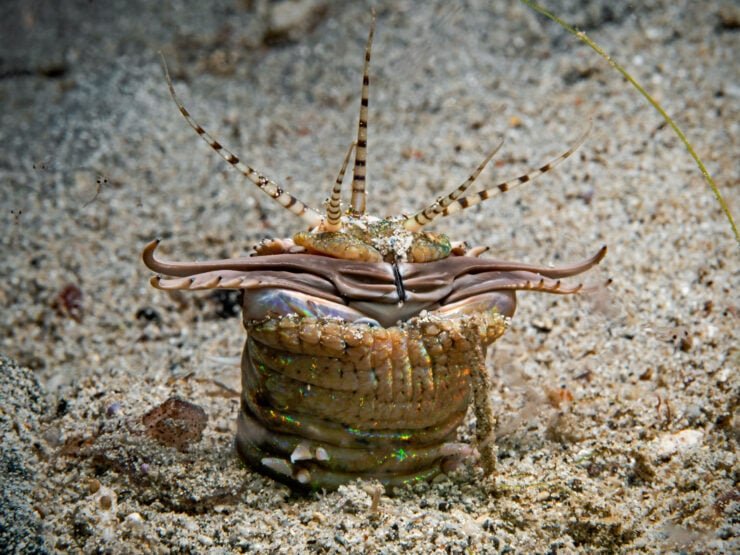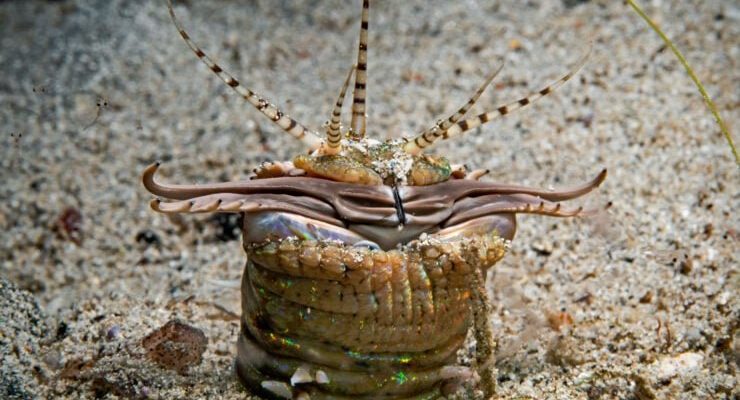
Picture the relationship between Bobbit worms and macroalgae like an intricate dance. Each partner has its unique moves, and together, they influence the health of the sandy seabed. When we delve into their interaction, we’re not just exploring two organisms; we’re unveiling a complex web of life that contributes to the overall balance of marine environments. So, grab your coffee, and let’s explore this unique relationship!
What Are Bobbit Worms?
Bobbit worms, scientifically known as *Eunice aphroditois*, aren’t your average garden variety. They’re marine polychaete worms that typically hide in the sand, showing only their colorful antennae. Named after the infamous Lorena Bobbitt, they’ve earned a reputation for being fierce predators. These worms lie in wait, striking fast to catch unsuspecting prey, like small fish and crustaceans, with their sharp jaws.
Why are they important? Bobbit worms serve as both predators and prey in their ecosystems. Their hunting behaviors help control the populations of smaller marine creatures. Furthermore, their burrowing activities aerate the sand, promoting a healthy substrate for other organisms, including macroalgae. This means they’re not just lurking in the depths; they play a vital role in maintaining balance in their habitats.
Understanding Macroalgae
Now, let’s talk about macroalgae. These sea plants are a huge part of marine life, providing essential habitats and food sources. Unlike tiny phytoplankton, macroalgae are larger and can be seen with the naked eye, often found clinging to rocks or drifting in the water. They come in various forms, from the leafy kelp forests to the simpler green algae.
What’s compelling about macroalgae is their ability to produce oxygen and absorb carbon dioxide, making them essential players in carbon cycling within marine environments. They offer shelter for numerous small creatures, which can benefit creatures like Bobbit worms. By creating a rich ecosystem above the sand, macroalgae can help sustain diverse marine life, demonstrating just how interconnected everything is underwater.
The Interaction Between Bobbit Worms and Macroalgae
So, how do Bobbit worms and macroalgae interact? Well, it all starts with the habitat. The sandy environments where Bobbit worms thrive often overlap with areas where macroalgae grow. The presence of macroalgae can provide shelter and protection for Bobbit worms, allowing them to hide and sneak up on prey.
But it’s not just a one-way street. Bobbit worms can influence macroalgae growth, too. As they burrow through the sand, they not only create space for macroalgae to root but also aerate the substrate. This aeration allows nutrients to circulate better, promoting healthier macroalgal growth. You might say they’re giving each other a helping hand—or in this case, a helping worm!
Benefits of Their Interaction in Aquatic Ecosystems
The relationship between Bobbit worms and macroalgae doesn’t just benefit these two organisms; it also enhances the entire aquatic ecosystem. Healthy macroalgae populations provide food and shelter for various marine species, creating a rich tapestry of life that includes everything from tiny shrimp to larger fish.
In turn, by aerating the sand and helping to establish a stable environment, Bobbit worms contribute to a flourishing ecosystem. When macroalgae thrive, they can absorb excess nutrients, preventing issues like algal blooms that can harm marine life. Thus, the interaction forms a symbiotic relationship, keeping the ecosystem balanced and thriving.
Challenges Faced by Bobbit Worms and Macroalgae
Even in their seemingly perfect partnership, Bobbit worms and macroalgae face challenges. Environmental changes, such as rising sea temperatures and ocean acidification, can disrupt their delicate balance. Macroalgae can suffer from overgrowth, leading to competition for space and resources, while Bobbit worms may struggle if their habitats are compromised.
Pollution and human activities can also harm these interactions. For instance, sedimentation from coastal development can smother macroalgae and disrupt the habitat Bobbit worms rely on. Keeping our oceans clean and protecting these environments is crucial for the health of Bobbit worms, macroalgae, and the entire marine ecosystem.
How to Support Healthy Ecosystems
If you’re interested in supporting the interactions between Bobbit worms and macroalgae, whether in your home aquarium or in local marine environments, here are some steps you can take:
- Reduce Pollution: Support initiatives to keep waterways clean and reduce plastic usage.
- Participate in Conservation: Get involved with local organizations focused on marine habitat preservation.
- Educate Others: Share knowledge about the importance of these interactions with friends and family.
- Maintain Your Aquarium: If you have a reef tank, ensure it mimics natural conditions to support both Bobbit worms and macroalgae.
By taking small steps, you can contribute to the health of these fascinating creatures and their environments.
The dynamic between Bobbit worms and macroalgae is a remarkable example of nature’s interconnectedness. As we’ve explored, they’re not just two separate entities; they’re part of a bigger picture that includes a thriving underwater ecosystem. Understanding their relationship helps us appreciate the complexity of marine life and reminds us of our role in protecting these environments.
Next time you think about sandbeds in the ocean, remember those unseen interactions happening beneath the surface. With every effort we make to maintain the health of our oceans, we’re supporting the dance between Bobbit worms and macroalgae—and the vibrant ecosystems they help sustain. So, let’s keep those waters clean and celebrate the wonders of marine life!

